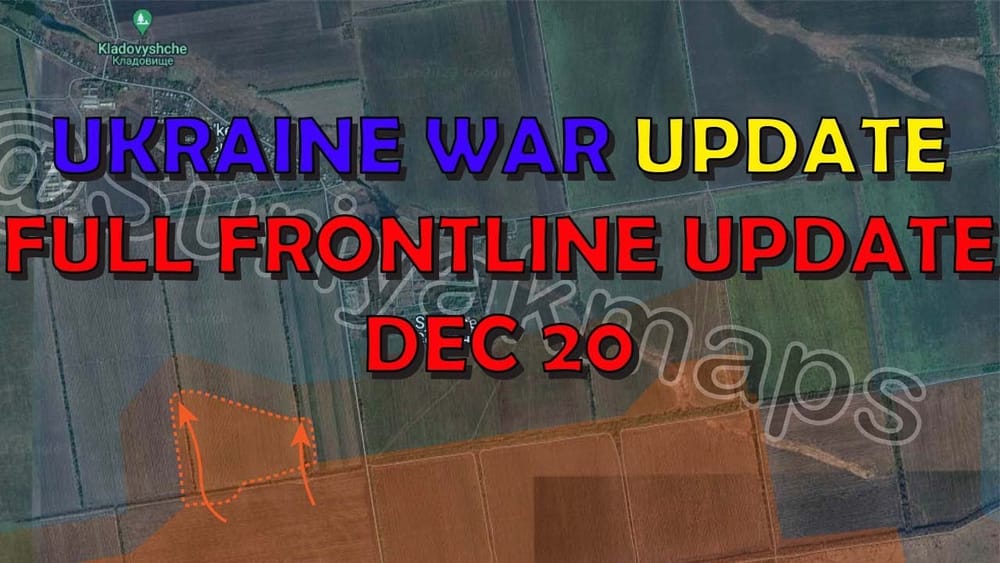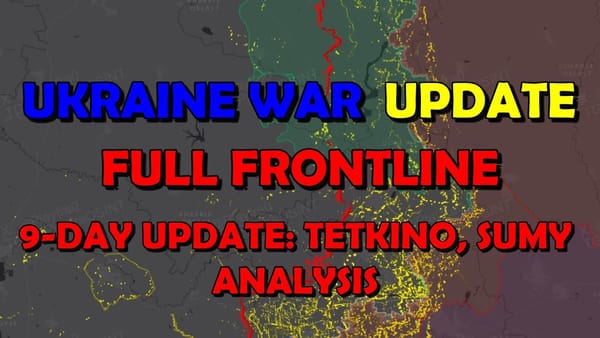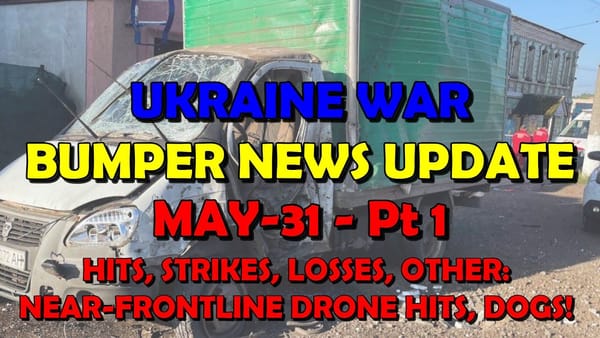Ukraine Conflict: Full Frontline Update
Table of Contents 📖
"They've got the mortar tubes and the artillery tubes to hit everything, but they don't have the ammunition. And as a result, the Russians are making gains."
Hello Team
🎦 00:00-01:47⏩
Jonathan welcomes viewers to his daily Ukraine War Frontline Update. He reminds viewers to familiarise themselves with the key to his map and mentions he will be adding pins in future. He sets the scene with footage of the conditions on the frontline showing mud and water making it difficult for military manoeuvres - making any military vehicles a target for munitions. Today's video will focus on Bakhmut in the Donetsk Oblast as this is where most of the activity is.
Return to top⤴️
📍 FRONT-LINE UPDATE -🗺️ MAP LEGEND

Bakhmut Frontline Update
🎦 01:47-11:06⏩
Jonathan starts by looking at Bakhmut and surrounding areas referencing the ISW reports and Syriac Maps. Jonathan explains that the situation in Bakhmut is worrying - the Russians have taken a large area of territory (according to Pro-Russian sources). There are claims of Ukrainian gains in the Andriivka area although Jonathan is unsure how reliable this information is. Jonathan says that the Russians are definitely pushing and having success everywhere else on this front. Jonathan highlights that Andrew Perpetua's (who does a daily livestream on the conflict) latest mapping updates, although accurate, don't make for positive viewing. However, he highlights the need for realism in understanding the situation. There is a clip from Andrew's livestream - Jonathan poses the question "Was Bakhmut lost because of lack of artillery?" The answer is yes - more specifically lack of mortar ammo. Andrew explains that they have some artillery ammunition but are having to use a lot of this to counter Russia's artillery which is not a bad thing - "that's what artillery's for". But it means they don't have enough to use for other purposes such as targeting Russian troops and tanks, and supporting their own infantry. Jonathan emphasises Andrew's point about the importance of mortars for defending territory and supporting infantry. This is why he (Jonathan) is so interested in this type of weaponry. Jonathan explains that because Ukraine doesn't have enough armour, tanks or infantry fighting vehicles it means their infantry do not have enough firepower to support themselves - and mortars are really the only firepower that can be given to them. Andrew believes that sending more drones to Ukraine (although helpful) is not the answer as drones cannot replace mortars. Mortars are special for defending territory. Ukraine desperately needs more mortar ammo. Jonathan goes on to highlight how many shells Ukraine needs and the challenges/delays in getting these to the country from the US and EU (specifically delays caused by Viktor Orbán). Jonathan says that footage from the area by the "Dachshunds" shows the situation in Bakhmut is not good and that although the Russians took territory the previous week, at high cost, there is evidence that the Ukrainians sustained losses - prisoners of war and others separated from their units. Jonathan questions the decision making processes that led to this. Jonathan then looks further south to Klishchiivka and refers to the trench network there. He says that the Russians have taken about half of the trench system although Andrew Perpetua disagrees with Syriac Maps who claim they have taken more. Jonathan believes it's just a matter of time before the Russians take the rest unless Ukraine can deploy more troops, armour, ammunition...more of everything. Jonathan highlights more areas of the map where the balance of control is uncertain and that it is not looking good for Ukraine around Bakhmut. However, he believes that Bakhmut is not strategically critical - Ukraine could cede more territory (around Khromove) to the Russians without it being too problematic. Although it would put Chasiv Yar under threat from artillery. Jonathan goes on to explain the strategic importance of territory in creating a buffer zone. But in the case of areas such as Kurdyumivka it doesn't really matter if it is lost. Jonathan highlights that Andrew Perpetua agrees with him about the importance of Nova-Mykhailivka. Jonathan then looks at the situation in Avdiivka (north of Nova-Mykhailivka) where there have been shifts in territory. He explains that if the Russians are taking the tree lines towards Tonenke as reported by Syriac maps, it will tighten the neck making the Ukrainians more vulnerable as it is harder for them to defend an open area such as Severny. Jonathan then returns to Bakhmut and asks what Ukraine's strategy is for the winter, and Bakhmut in particular? He goes on to discuss Anders Puck Nielsen's videos about the Russian "meat waves" and how this strategy is, whether we like it or not, proving successful in enabling Russia to take and hold territory, albeit at huge cost. Jonathan explains this is acceptable to Russia because they place less value on human life than other countries. This disregard for human life is a successful tactic for them if they have enough troops to replace their losses - and this is one of the messages they want to convey to the world.
Return to top⤴️
Russian Military Tactics and their impact on Ukraine and the West
🎦 11:06-18:04⏩
Jonathan explains that Russia is sending a message to the west: "Look what we are prepared to do - how far are you willing to go?". Jonathan poses the question: How can this be countered? His answer is more ammunition for Ukraine. He explains that even with an 8:1 advantage, the Russians could be kept at bay if they were being hit hard by artillery and mortars. This is what happened at Avdiivka which is why their gains there were limited although the loss of human life was high. Jonathan believes we are seeing the impact of this lack of ammunition for Ukraine in the Donbas where Russia is gaining ground. Jonathan argues that it is cheaper to keep Ukraine supplied with the equipment it needs to defend territory now, than it is to retake it later - as well as the cost in human life. He is very critical of the delays and issues in getting military aid to Ukraine. Jonathan then returns to Avdiivka where footage appears to confirm the Russians are advancing near the quarry. He goes on to say that the situation in Nova-Mykhailivka is looking bad (he will return to this later) as there has been no let up in Russian attacks in the area. Jonathan confirms that Surat Maps and Andrew Perpetua agree that Russian forces have made gains to the east of the town. The ISW reports (although without providing a footnote) that Russian forces have made small gains on the outskirts of the town. They also report that Russia has captured an agricultural complex on the south-western edge of the town although the ISW have not confirmed this. Jonathan emphasises the importance of holding this territory in order to prevent Vuhledar being attacked. He reiterates the importance of Nova-Mykhailivka and how the situation is looking increasingly precarious.
Return to top⤴️
Zaporizhia Frontline Update
🎦 18:04-29:36⏩
Jonathan moves south, bypassing Velyka Novosilka where there has been some activity, but nothing significant to report. He explains that according to Surat Maps the Russians have continued to advance North of the main defensive line to the east of Novopropivka. They have crossed the trench lines and advanced up to the treelines. However, he agrees with Andrew Perpetua that losing this territory is not that significant in the context of the entire conflict and questions whether it was strategically advantageous for Ukraine to hold. Jonathan reiterates that Nova-Mykhailivka is his primary concern, followed by Krinke. Although there is no change to report in the latter, he provides analysis of the situation there. He provides an update on the situation near Novopropivka, reporting that geolocated footage confirms Russian advances in the area. The 33rd Mechanised Brigade had a direct hit on 4 Russian military personnel 570m north of their previous known location. There is very little footage coming out of the area. Jonathan speculates that Ukraine may have made a tactical withdrawal from the area to Robotyne which although a form of retreat, would make sense as it is easier to defend. Jonathan shows footage of the drone strike on the four Russian soldiers and explains that although this is further north than has been reported previously, it does not necessarily follow that Russia controls this area. He suspects Syriac Maps may be prematurely claiming this for Russia. He says this is more likely to be an area that is contested and although he is inclined to agree with Andrew Perpetua's analysis, only time will tell. Jonathan returns to Krinke, explaining that he expects the situation here to be attritional for the Ukrainians and that the Russians will probably be able to take it - he explains his reasoning for this. He does not believe Ukraine has the military capacity to expand the bridgehead, and doubts they will receive the equipment required anytime soon. Although it will be hard fought, he predicts the Russians will take Krinke, pushing the Ukrainians back across the Dnipro River. Jonathan discusses the issue of reserves and how his previous assessments of the situation may have been wrong, using the example of the troops that were stationed in Belarus which have now been redeployed. Although Russia may not have huge reserves in areas such as Zaporizhzhia, they can call on conscripts (official and crypto) to bolster their numbers - and as long as they can do this at a rate that outpaces Ukraine's ability to do the same, they will prevail. This reinforces his point about the Russian "meat wave" tactic.
Return to top⤴️
Importance of Drones and Standoff Weapons
🎦 29:36-31:08⏩
Jonathan reiterates that Ukraine needs to find other ways to fight back, for example standoff weapons, HIMARS and other long range missiles as well as drones. He is encouraged by the news that Ukraine is ramping up its own production of drones - 50,000 last month and a target of 1 million next year, as well as receiving drones from other countries. This is how Ukraine will be able to counter Russia's superior human resources. He believes that Ukraine needs 450,000 - 500,000 troops in order to be able to take back the territory that Russia has taken. He is critical of the west's delay in providing the equipment Ukraine needs and believes that if this had been provided earlier, the situation would be different.
Return to top⤴️
F-16s and Russian Missile Strategy
🎦 31:08-31:44⏩
Jonathan speculates that Russia may be holding back on its missile attacks because they are waiting for the F-16 fighter jets to arrive. Once Ukraine takes delivery of these and their location is known, it is highly likely that Russia will target these with missiles. He believes that Russia will see this as an opportunity to strike a blow and demoralise Ukraine.
Return to top⤴️
Wrap up
🎦 31:44-32:38⏩
Jonathan thanks his viewers and acknowledges that the news from the frontline is not positive. He encourages his viewers to donate to Ukrainian charities and to challenge the Russian narrative at every opportunity.
Return to top⤴️



